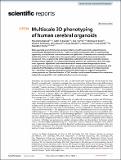Multiscale 3D phenotyping of human cerebral organoids
Author(s)
Albanese, Alexandre; Swaney, Justin M; Yun, Dae Hee; Evans, Nicholas B; Antonucci, Jenna M; Velasco, Silvia; Sohn, Chang Ho; Arlotta, Paola; Gehrke, Lee; Chung, Kwanghun; ... Show more Show less
DownloadPublished version (8.830Mb)
Publisher with Creative Commons License
Publisher with Creative Commons License
Creative Commons Attribution
Terms of use
Metadata
Show full item recordAbstract
Brain organoids grown from human pluripotent stem cells self-organize into cytoarchitectures resembling the developing human brain. These three-dimensional models offer an unprecedented opportunity to study human brain development and dysfunction. Characterization currently sacrifices spatial information for single-cell or histological analysis leaving whole-tissue analysis mostly unexplored. Here, we present the SCOUT pipeline for automated multiscale comparative analysis of intact cerebral organoids. Our integrated technology platform can rapidly clear, label, and image intact organoids. Algorithmic- and convolutional neural network-based image analysis extract hundreds of features characterizing molecular, cellular, spatial, cytoarchitectural, and organoid-wide properties from fluorescence microscopy datasets. Comprehensive analysis of 46 intact organoids and ~ 100 million cells reveals quantitative multiscale “phenotypes" for organoid development, culture protocols and Zika virus infection. SCOUT provides a much-needed framework for comparative analysis of emerging 3D in vitro models using fluorescence microscopy.
Date issued
2020Department
Massachusetts Institute of Technology. Institute for Medical Engineering & Science; Picower Institute for Learning and Memory; Massachusetts Institute of Technology. Department of Chemical Engineering; Massachusetts Institute of Technology. Department of Brain and Cognitive Sciences; Harvard University--MIT Division of Health Sciences and TechnologyJournal
Scientific Reports
Publisher
Springer Science and Business Media LLC